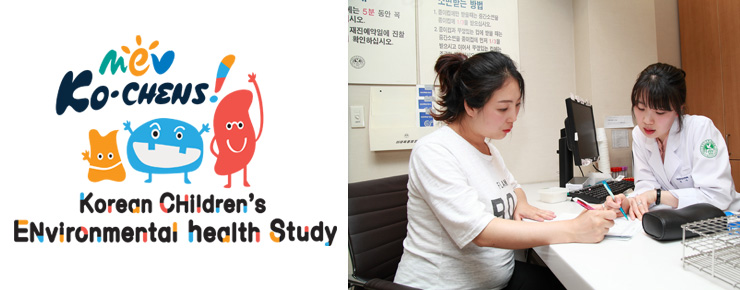The research support center for Ko-CHENS

The Korean Children’s Environmental Health Study(Ko-CHENS)
Recently variety of chemical substances has been used so that the exposures to environmental toxicants for humans have increased. Hence the increase has brought about the rise in environmental diseases. We have observed the consistently increasing occurrence of representative environmental diseases such as asthma, atopic dermatitis, and allergic rhinitis from 2002. In 2009 with comparison to 2002, allergic rhinitis occurrence increased up to 76 percent, asthma occurrence not in rapid increasing but up to 9% and atopic dermatitis showed similar aspect(Health insurance statistical yearbook,2010).
The results in Health Effect Survey for pregnant women and children have confirmed that the occurrences of environmental diseases is due to the exposure to environmental toxicants. For example, more than 40 percent of all patients suffering asthma, atopic dermatitis, and allergic rhinitis are aged below 19 (Health insurance statistical yearbook, 2010). Nevertheless, the scientific investigation for children’s health protection in the life course approach from the prenatal period up to adolescent has done insufficiently.
Moreover, medical expenses for asthma during the recent three years, from 2010 to 2012, were 285billion 60 million won~330 billion 70 million won in Korea. 34-40 percent of the total expenses were used for patients under 19 which cost around 97billion won-131 billion 30milion won.
Therefore, It is necessary to establish National health management system which provide information that include scientific rationale by examining risk factors in children’s growth stages for environmental diseases.
The new cohort study, the Korean Children’s Environmental Health Study(Ko-CHENS) is organized. Ko-CHENS is conducted on the basis of combining the original Mothers and Children's Environmental Health study(MOCEH) and other related researches. Extension of Ko-CHENS will be designed according to the outcomes and findings generated by the ongoing cohort study.
Ko-CHENS study design, based on pregnancy women, is including two data collection methods; main study and core study. Ko-CHENS study started from 2015 and the follow-up survey is conducted in every growth stages for the following 17 years. In Every follow-up period (infants and toddlers, preschoolers, elementary, middle school, and high school students), the survey will be conducted through government departments’ close cooperation and the study outcome will be evaluated at the end of each period. The consolidated research work (data) report and the environmental health guidelines based on the Ko-CHENS will be published in roughly every three years.
| Main study | Core study | |
|---|---|---|
| study period | 2015~2036 (22 years, from the prenatal period until the age of 18) |
|
| Recruitment period | 2015~2018 (4years) | 2015~2017 (3years) |
| Target participants | 65,000 pregnant women | 5,000 pregnant women |
| Recruiting Institute | Public health care centers/Obstetric units in the hospitals | Obstetric units in the hospitals/Public health care centers |
| Follow-up period | Through linkage to national health registries | 20 years through hospital visits |

We expect a few goals which can be achieved by the new cohort study, Ko-CHENS, which are investigating environmental health risk factors for mother, children, and adolescent, establishing environmental health management system for mother, children, and adolescent, and providing information to prevent environmental exposures; that is, providing guidelines such as individual practice methods.
Furthermore, we have the ultimate aim by Ko-CHENS, which is ‘The prevention and extermination of environmental diseases’. Especially it is essential to reduce environmental exposure and implement preventative management in early life course in order to prevent and exterminate environmental diseases.

